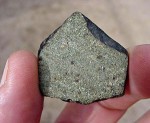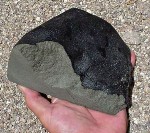NASA scientists electrified the world in August, 1996 when they announced the discovery of a fossiliferous stone meteorite from Mars. The fossils, visible only with a scanning electron microscope, were of microorganisms resembling bacteria or yeast cells, similar to those found on Earth. The Antarctic meteorite, known as Alan Hills 84001, was dated at 3.5 billion years, and was apparently formed during the early stages of Mars’ development when the planet had free liquid water on its surface.
As news of this evidence of life on another planet rocketed around the world, phones at Robert Haag Meteorites started ringing off the hook. Scientists and collectors from all over were seeking other kinds of Mars rock, such as Zagami, for investment and study.
Alan Hills 84001, obviously one of a kind, so far, is just one of a few Mars rocks that have already been found on Earth. Others belong to the extremely rare group of meteorites classified as belonging to the SNC group (pronounced “snick”). The acronym stands for the initials of the first three known falls of Martian material, namely Shergotty, India; Nakhla, Egypt; and Chassigny, France. Nakhla
Nakhla
more… Zagami
Zagami
more…